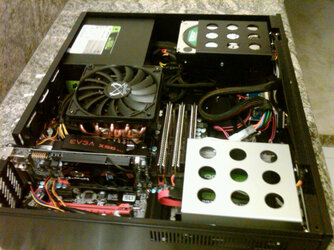Howdy everybody,
I have a small home theater PC (Moncaso 312b). As you can see in the picture below (From google search, this isn't mine) space is VERY limited. That said I'd love to water cool the thing. As a HTPC I'd prefer it to be much quieter than it is, and it is already running hot as is (no overclocking or anything).
I know very little about watercooling in general, and am wondering if it is even possible in such a space constrained system. At first I thought there was no way, but then this little guy caught my eye: http://www.frozencpu.com/products/1...ini_II_Dual_40mm_Radiator.html?tl=g30c95s1311
The back of the MonCaso supports space for 3 side by side 40mm fans so this radiator might actually work. That said I have no idea what to do for a reservoir or pump. Any thoughts on the smallest but yet still effective components around? Also I noticed that the radiator I linked above says that it supports hoses with inner dimensions of 8mm. That doesn't seem to give with either 1/2 or 3/8ths hosing... so what's the deal there?
Thanks!

I have a small home theater PC (Moncaso 312b). As you can see in the picture below (From google search, this isn't mine) space is VERY limited. That said I'd love to water cool the thing. As a HTPC I'd prefer it to be much quieter than it is, and it is already running hot as is (no overclocking or anything).
I know very little about watercooling in general, and am wondering if it is even possible in such a space constrained system. At first I thought there was no way, but then this little guy caught my eye: http://www.frozencpu.com/products/1...ini_II_Dual_40mm_Radiator.html?tl=g30c95s1311
The back of the MonCaso supports space for 3 side by side 40mm fans so this radiator might actually work. That said I have no idea what to do for a reservoir or pump. Any thoughts on the smallest but yet still effective components around? Also I noticed that the radiator I linked above says that it supports hoses with inner dimensions of 8mm. That doesn't seem to give with either 1/2 or 3/8ths hosing... so what's the deal there?
Thanks!
